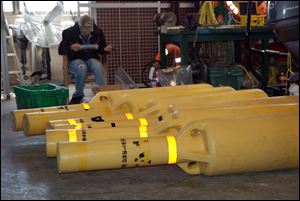
Canadians alert for missing buoys
12/14/2012
Scientific buoys that were placed on Lake Erie lie on the floor of a storage unit. The buoys are used to record temperature data of the lake. Three are missing, and the officials are asking for help to recover them.
The best friend we have on the planet is asking for a hand. Because that’s what good neighbors do, Canada should be able to rely on the folks in Michigan and Ohio to help out.
The Ontario Ministry of Natural Resources is searching for three missing scientific buoys that apparently worked loose from their moorings on Lake Erie.
The Lake Erie Management Unit from the province positioned the buoys in the west-central area of the lake in the spring, in places where the water is 33, 49, and 66 feet deep. When crews went out to retrieve the buoys this fall, they were gone.
What makes the buoys so valuable is that they act like bobbing, floating, 24-hour scientists for the duration of their stay in the lake.
Instruments on board take hourly water temperature readings, providing biologists with an extensive temperature profile. From that information, scientists can glean data critical to a number of on-going studies on the health of the lake.
“In particular, we are interested in what is happening above and below the hypolimnion — the boundary layer between the warmer, more oxygenated surface water and the colder, lower oxygenated water in the deeper areas of the lake,” said John Cooper of the ministry’s Fish and Wildlife Services.
Cooper said that stationary temperature recording stations like these buoys provide vital “after the fact” information, such as the timing and severity of water temperature changes during extreme weather events. These phenomena can result in the colder, less oxygenated water surging closer to the surface, often causing localized fish die-offs.
The missing buoys are about six-feet long, and on the lower end their circumference is such that it would be difficult to wrap your arms around the cylinder. They are made of hard plastic and were bright yellow when placed in the lake. Cooper said the shape of the buoys is similar to that of the green and red navigational markers that are common in many sections of the lake.
Cooper said the ministry positions six of the data-collecting buoys in Lake Erie’s Western Basin each year. Three are placed west of Point Pelee, and three to the east of Pelee, that long peninsula that juts sharply out into the lake, forming the southernmost point on the Canadian mainland.
The three buoys that were anchored west of Point Pelee were successfully retrieved by the ministry, but when crews attempted to collect the additional three buoys, they found the anchors, but the buoys and the chains with the valuable data loggers were gone.
Cooper said the Ontario DNR is not certain when the buoys worked loose from their moorings, and volatile weather events make it tough to determine just which direction the wind and waves might have carried the floating cylinders.
If the prevailing winds did indeed prevail, the buoys could have ended up on some of the remote Ontario shoreline of Lake Erie, in the Rondeau or Port Stanley areas. Steep bluffs are chiseled into the land in that region, making the search even tougher.
But since Hurricane Sandy crashed onto the scene and turned Lake Erie into a nasty, roiling mess, the plot thickens. Storm events of that magnitude could have torn the buoys loose and tossed them south toward the Ohio shoreline, or west toward Michigan. That’s where we join the search party.
Cooper said the buoys could be partially buried in the sand along the shore and tough to see. They were originally marked ‘TA 3,’ ‘TA 4,’ and ‘TA 5,’ and carried the “Ministry of Natural Resources” name and phone number, but those identifying marks could have been scraped away by rocks or rubbed off by sand.
Information collected by the buoys is valuable in the work of the Forage Task Group of the Lake Erie Committee of the Great Lakes Fishery Commission, Cooper added. The province of Ontario works in conjunction with Ohio, Michigan, Pennsylvania, and New York “to monitor and measure the changes happening at the lower trophic levels of the Lake Erie food web,” Cooper said.
Agencies from the province and the four states combine their resources to track a wide range of key variables that measure changes in the lake’s ecosystem. Samples are taken throughout the late spring, summer, and early fall to record surface water temperatures, dissolved oxygen at the lake bottom, chlorophyll concentrations, zooplankton, water transparency, and total phosphorus.
“The goal is to maintain conditions in the western, central, and near-shore waters of the eastern basin [of Lake Erie] that favor fish species such as walleye, smallmouth bass, and yellow perch, and conditions in the deep, colder water of the eastern basin that favor fish species such as lake trout and whitefish,” Cooper said.
If one of the missing buoys is found in Ohio or Michigan waters, Cooper asked that a call be placed to the Ontario Ministry of Natural Resources’ Lake Erie Management Unit at 519-825-4684 or an email be sent to brian.locke@ontario.ca as soon as possible.
Contact Blade outdoors editor Matt Markey at: mmarkey@theblade.com or 419-724-6068.